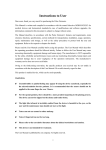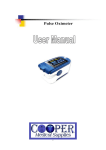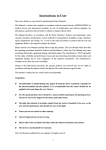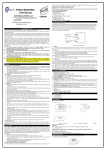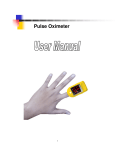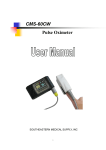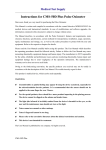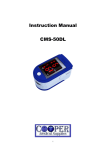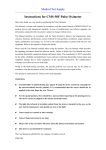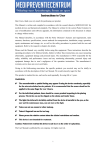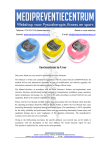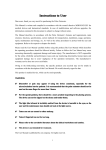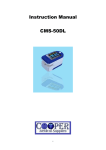Download Clini-Ox II
Transcript
Clini-Ox II FINGERTIP PULSE OXIMETER Instructions to User Item # 18708 www.drivemedical.com Dear Users, This manual is written for the Clini-Ox II Fingertip Pulse Oximeter, part number 18708. In case of modifications and software upgrades, the information contained in this document is subject to change without notice. The manual describes, in accordance with the Clini-Ox II’s features and requirements, main structure, functions, specifications, correct methods for transportation, installation, usage, operation, repair, maintenance and storage, etc. as well as the safety procedures to protect both the user and equipment. Refer to the respective chapters for details. 1 Please read the manual very carefully before using this equipment. These instructions describe the operating procedures to be followed strictly, failure to follow these instructions can cause measuring abnormality, equipment damage and personal injury. The manufacturer is NOT responsible for the safety, reliability and performance issues and any monitoring abnormality, personal injury and equipment damage due to user’s negligence of the operation instructions. The manufacturer’s warranty service does not cover such faults. This expected service life of this device is 3 years. 2 WARNING • An uncomfortable or painful feeling may occur if using the device ceaselessly, especially for the micro-circulation barrier patients. It is recommended that the sensor should not be applied to the same finger for over 2 hours. • For the individual patients, there should be a more prudent inspecting in the placing process. The device cannot be clipped on the edema and tender tissue. • The light (the infrared is invisible) emitted from the device is harmful to the eyes, so the user and technician, should not stare at the light. • Patient should not use enamel or other makeup. • Patient’s fingernail should not be too long. 3 • Please read the relative content about the clinical restrictions and caution. • This device is not intended for treatment. CAUTION: Federal law restricts this device to sale by or on the order of a physician. 4 TABLE OF CONTENTS 1. Safety.............................................................................................. 8 1.1 Instructions for Safe Operations............................................ 8 1.2 Warnings........................................................................................... 9 1.3 Attentions........................................................................................ 10 1.4 Indication for Use......................................................................... 14 2. Overview........................................................................................ 15 2.1 Classification.................................................................................. 16 2.2 Features............................................................................................ 16 2.3 Environment Requirements................................................... 17 3. Principle and Caution.................................................................. 18 3.1 Principle of Measurement....................................................... 18 5 3.2 Caution............................................................................................... 21 3.3 Clinical Restrictions...................................................................... 22 4. Technical Specifications................................................................ 24 5. Accessories..................................................................................... 27 6. Installation..................................................................................... 28 6.1 View of the Front Panel.............................................................. 28 6.2 Battery................................................................................................ 29 6.3 Mounting the Hanging Rope.................................................. 30 7. Operating Guide........................................................................... 31 8. Repairing and Maintenance........................................................ 31 9. Troubleshooting......................................................................... 37-40 6 10. Key of Symbols........................................................................... 41-43 11. Function Specification.............................................................. 44-46 Appendix........................................................................................... 47-56 Warranty............................................................................................ 57 7 1. SAFETY 1.1 Instructions for Safe Operations » Check the main unit and all accessories periodically to make sure that there is no visible damage that may affect user’s safety and monitoring performance about cables and transducers. It is recommended that the device should be inspected once a week at least. When there is obvious damage, stop using the monitor. » Necessary maintenance must be performed by qualified service engineers ONLY. Users are not permitted to maintain it by themselves. For the individual patients, there should be a more prudent inspecting in the placing process. The device cannot be clipped on the edema and tender tissue. 8 » The oximeter cannot be used together with devices not specified in User’s Manual. Only the accessory recommended and suppled by the manufacture can be used with this device. » This product is calibrated before leaving factory. 1.2 Warnings » Explosive hazard—DO NOT use the oximeter in environment with inflammable gas such as some ignitable anesthetic agents. » DO NOT use the oximeter while the patient is measured by MRI and CT. » The person who is allergic to rubber cannot use this device. » The disposal of scrap instrument and its accessories and 9 packing (including battery, plastic bags, foams and paper boxes) should follow the local laws and regulations. » Please check the packing before use to make sure the device and accessories are totally in accordance with the packing list, or else the device may have the possibility of working abnormally. 1.3 Attentions » Keep the oximeter away from dust, vibration, corrosive substances, explosive materials, high temperature and moisture. » If the oximeter gets wet, please stop operating it. » When it is carried from cold environment to warm or 10 humid environment, please do not use it immediately. » DO NOT operate keys on front panel with sharp materials. » High temperature or high pressure steam disinfection of the oximeter is not permitted. Refer to User Manual in the relative chapter for instructions of cleaning and disinfection. » Do not have the oximeter immersed in liquid. When it needs cleaning, please wipe its surface with medical alcohol by soft material. Do not spray any liquid on the device directly. » When cleaning the device with water, the temperature should be lower than 140°F (60°C). » As to the fingers which are too thin or too cold, it would probably affect the normal measure of the patients’ SpO2 and pulse rate, please clip the thick finger such as thumb and 11 middle finger deeply enough into the probe. » Do not use the device on infant or neonatal patients. » The product is suitable for children above four years old and adults. » The device may not work for all patients. If you are unable to achieve stable readings, discontinue use. » The update period of data is less than 5 seconds, which is changeable according to different individual pulse rate. » The waveform is normalized. Please read the measured value when the waveform on screen is equably and steady-going. Here this measured value is optimal value. And the waveform at the moment is the standard one. » If some abnormal conditions appear on the screen during 12 test process, pull out the finger and reinsert to restore normal use. » The device has normal useful life for three years since the first electrified use. » The hanging rope attached the product is made from Non- allergy material, if particular group are sensitive to the hanging rope, stop using it. In addition, pay attention to the use of the hanging rope, do not wear it around the neck to avoid potential patient injury. » The instrument does not have low-voltage alarm function; it only shows the low-voltage. Please change the battery when the low battery warning appears. » Batteries must be removed if the device is going to be 13 stored for more than one month, or else batteries may leak. » A flexible circuit connects the two parts of the device. Do not twist or pull on the connection. 1.4 Indications for Use The Clini-Ox II Fingertip Pulse Oximeter is a non-invasive device intended for the spot-check of oxygen saturation of arterial hemoglobin (SpO2) and the pulse rate of adult and pediatric patients in home and hospital environments (including clinical use in internist/ surgery, anesthesia, intensive care ect.). This device is not intended for continuous monitoring. 14 2. OVERVIEW The pulse oxygen saturation is the percentage of HbO2 in the total Hb in the blood, so-called the O2 concentration in the blood. It is an important bio-parameter for the respiration. For the purpose of measuring the SpO2 more easily and accurately, the Clini-Ox II Pulse Oximeter was developed. At the same time, the device can measure the pulse rate simultaneously. The Clini-Ox II Pulse Oximeter convenient operation, low power consumption, and is compact and portable. It is only necessary for patient to put one of his fingers into a fingertip photoelectric sensor for diagnosis, and a display screen will directly show measured value of Hemoglobin Saturation. 15 2.1 Classification » Class II b, (MDD93/42/EEC IX Rule 10) 2.2 Features » Operation of the product is simple and convenient. » The product is small in volume, light in weight (total weight is about 1.8oz (50g) including batteries) and convenient in carrying. » Power consumption of the product is low and the two originally equipped AAA batteries can be operated continuously for 20 hours. » The product will automatically be powered off when no signal is in the product within 5 seconds. 16 » » 4 directions display mode without waveform. Waveform display mode as line drawing or filling manner. The product is not suitable for use in continuous supervision for patients. The problem of overrating would emerge when the patient is suffering from toxicosis which caused by carbon monoxide, the device is not recommended to be used under this circumstance. 2.3 Environment Requirements Storage Environment a) Temperature: -40° F ~ 140° F (-40° C ~60° C) 17 b) Relative humidity: ≤ 95% c) Atmospheric pressure: 500hPa ~ 1060hPa Operating Environment a) Temperature: 50° F ~ 104° F (10° C ~40° C) b) Relative Humidity: ≤ 75% c) Atmospheric pressure: 700hPa ~ 1060hPa 3. PRINCIPLE AND CAUTION 3.1 Principle of Measurement Principle of the Oximeter is as follows: An experience formula of data process is established taking use of Lambert Beer Law according to Spectrum Absorption Characteristics of Reductive Hemoglo18 bin (Hb) and Oxyhemoglobin (HbO2) in glow & near-infrared zones. Operation principle of the instrument is: Photoelectric Oxyhemoglobin Inspection Technology is adopted in accordance with Capacity Pulse Scanning & Recording Technology, so that two beams of different wavelength of lights can be focused onto human nail tip through perspective clamp finger-type sensor. Then measured signal can be obtained by a photosensitive element, information acquired through which will be shown on screen through treatment in electronic circuits and microprocessor. 19 Figure 1 20 3.2 Caution 1. The finger should be placed properly (see the attached illustration of this manual, Figure 5), or else it may cause inaccurate measurement. 2. The SpO2 sensor and photoelectric receiving tube should be arranged in a way with the subject’s arteriole in position between the sensors. 3. The SpO2 sensor should not be used at a location or limb tied with arterial canal or blood pressure cuff or receiving intravenous injection. 4. Make sure the optical path is free from any optical obstacles like rubberized fabric. 5. Excessive ambient light may affect the measuring result. It 21 6. 7. includes fluorescent lamp, dual ruby light, infrared heater, direct sunlight, etc. Strenuous action of the subject or extreme electro-surgical interference may also affect the accuracy. Testee cannot use enamel or other makeup. 3.3 Clinical Restrictions 1. As the measure is taken on the basis of arteriole pulse, substantial pulsating blood flow of subject is required. For a subject with weak pulse due to shock, low ambient/body temperature, major bleeding, or use of vascular contracting drug, the SpO2 waveform (PLETH) will decrease. In this case, the measurement will be more sensitive to interference. 22 2. 3. 4. 23 For those with a substantial amount of staining dilution drug (such as methylene blue, indigo green and acid indigo blue), or carbon monoxide hemoglobin (COHb), or methionine (Me+Hb) or thiosalicylic hemoglobin, and some with icterus problem, the SpO2 determination by this monitor may be inaccurate. The drugs like dopamine, procaine, prilocaine, lidocaine and butacaine may also be a major factor blamed for serious error of SpO2 measure. As the SpO2 value serves as a reference value for judgment of anemic anoxia and toxic anoxia, some patients with serious anemia may also report good SpO2 measurement. 4. TECHNICAL SPECIFICATIONS 1. Display Format: OLED Display SpO2 Measuring Range: 0% ~ 100%; Pulse Rate Measuring Range: 30 bpm ~ 250 bpm; Pulse Wave Display: Columniation display and the waveform display. 2. Power Requirements: 2 × 1.5V AAA alkaline battery (or using the rechargeable battery instead), adaptable range: 2.6V~3.6V. 3. Power Consumption: Smaller than 30mA. 4. Resolution: 1% for SpO2 and 1 bpm for Pulse Rate. 24 5. Measurement Accuracy: ±2% in stage of 70%-100% SpO2, and meaningless when stage being smaller than 70%. ±2 bpm during the pulse rate range of 30-99 bpm and ±2% during the pulse rate range of 100~250 bpm. 6. Measurement Performance in Weak Filling Condition: SpO2 and pulse rate can be shown correctly when pulse-filling ratio is 0.4%. SpO2 error is ±4%, pulse rate error is ± 2 bpm during the pulse rate range of 30~99 bpm and ±2% during the pulse rate range of 100~250 bpm. 7. Resistance to surrounding light: The deviation between the value measured in the condition of man-made light or indoor natural light and that of darkroom is less than ±1%. 25 8. It is equipped with a function switch. The oximeter will power off automatically after 5 seconds without a finger present between the sensors. 9. Optical Sensor Red light (wavelength is 660nm, 6.65mW) Infrared (wavelength is 880nm, 6.75mW) 26 5. ACCESSORIES » » » 27 One hanging rope Two batteries One User manual 6. INSTALLATION 6.1 View of the Front Panel SpO2 Figure 2 pulse rate button pulse bar graph pulse waveform 28 6.2 Battery Step 1. Refer to Figure 3 and insert the two AAA size batteries properly in the right direction. Step 2. Replace the cover. Please take care when you insert the batteries for the improper insertion may damage the device. Figure 3 29 6.3 Mounting the Hanging Rope Step 1. Put the end of the rope through the hole. Step 2. Put another end of the rope through the first one and then tighten it. Figure 4 30 7. OPERATING GUIDE 1. Insert the finger into the clip as shown in Figure 5. 31 Figure 5 2. Place the patient’s finger onto the rubber cushions of the clip (make sure the finger is in the right position), and then clip the finger. 3. Press the switch button once on front panel. 4. Do not shake the finger and keep the patient at ease during the process. 5. Get the information directly from screen display. 6. The button has three functions. When the device is power off, pressing the button can turn on the unit. When the device is power on, pressing the button shortly can change direction of the screen (Fig. 6 – 11). When the device is power on, pressing the button long can change brightness of the screen. 32 33 Figure 6: Display mode 1 Figure 7: Display mode 2 Figure 8: Display mode 3 Figure 9: Display mode 4 Figure 10: Display mode 5 Figure 11: Display mode 6 Fingernails and the luminescent tube should be on the same side. 34 8. REPAIRING AND MAINTENANCE » Please change the batteries when the low-voltage displayed on the screen. » Please clean the surface of the device before using. Wipe the device with medical alcohol first, and then let it dry in air or clean it by dry clean fabric. » Using the medical alcohol to disinfect the product after use, prevent from cross infection for next time use. » Please take out the batteries if the oximeter is not in use for a long time. » The best storage environment of the device is - 40°C to 35 60°C ambient temperature and not higher than 95% relative humidity. Necessary maintenance and calibration may only be performed by Authorized Drive Medical Service Professionals. Users are not permitted to performance product maintenance or calibration of the Clini-Ox II. High-pressure sterilization cannot be used on the device. Do not immerse the device in liquid. It is recommended that the device should be kept in a dry environment. Humidity may reduce the useful life of the device, or even damage it. 36 9. TROUBLESHOOTING Trouble 37 Possible Reason The SpO2 and Pulse Rate cannot be displayed normally. 1. The finger is not properly positioned. 2. The patient’s SpO2 is too low to be detected. The SpO2 and Pulse Rate are not displayed stably. 1. The finger is not positioned correctly. 2. The finger is shaking or the patient is moving. Solution 1. Place the finger properly and try again. 2. Try again; Contact your physician if you are sure the device is operating correctly. 1. Place the finger properly and try again. 2. Keep the patient calm. 38 9. TROUBLESHOOTING CONTINUED Trouble The device cannot be turned on. Possible Reason 1. The batteries are drained or almost drained. 2. The batteries are not inserted properly. 3. Malfunction of the device. The display turns off 1. The device will power off automatically suddenly. when it gets no signal within 5 seconds. 2. The batteries are almost drained. 39 Solution 1. Change batteries. 2. Reinstall batteries. 3. Please contact your local equipment provider. 1. Normal. 2. Change batteries. 40 10. KEY OF SYMBOLS Symbol Description Type BF Warning – See User Manual The pulse oxygen saturation (%) PRbpm Pulse rate (bpm) The battery voltage indication is deficient (change the battery in time avoiding the inexact measure). 41 1. No finger inserted. 2. An indicator of signal inadequacy. Symbol Description Battery positive electrode Battery cathode 1. Power switch 2. Change direction of the screen 3. Change brightness of the screen SN Serial number Alarm inhibit 42 Symbol Description WEEE (2002/96/EC) IP22 43 International Protection 10. FUNCTION SPECIFICATION Display Information Display Mode The Pulse Oxygen Saturation (SpO2) OLED Pulse Rate (PR) OLED Pulse Intensity (bar-graph) OLED bar-graph display Pulse wave OLED 44 SpO2 Parameter Specification Measuring range 0%~100%, (the resolution is 1%) Accuracy 70%~100%: ±2%, Below 70% unspecified Optical Sensor Red light (wavelength is 660nm) Infrared (wavelength is 880nm) Pulse Parameter Specification Measuring range 30bpm~250bpm (the resolution is 1 bpm) Accuracy ±2bpm or±2% select larger 45 Pulse Intensity Range Continuous bar-graph display, the higher display indicates a stronger pulse. Battery Requirement 1.5V (AAA size) alkaline batteries (× 2) or rechargeable battery Battery Useful Life Two batteries can work continually for 20 hours Dimensions & Weight Dimensions 2.2 (L) x 1.2 (W) x 1.3 (H) in (57(L) × 31(W) × 32(H) mm) Weight About 1.8oz (50g) with the batteries 46 APPENDIX Guidance & Manufacturer’s Declaration-Electromagnetic Emission for all EQUIPMENT and SYSTEMS Guidance & Manufacturer’s Declaration–Electromagnetic Emission The Clini-Ox II 18708 Fingertip Pulse Oximeter is tended for use in the electromagnetic environment specified below. The healthcare provider of the patient of the 18708 should assure that the Clini-Ox II is issued in such an environment. 47 Electromagnetic environment-guidance Emission Test Compliance RF emissions CISPR 11 Group 1 The 18708 uses RF energy only for their internal function. Therefore, its RF emissions are very low and are not likely to cause any interference in nearby electronic equipment. RF emissions CISPR 11 Class B Harmonic emissions IEC 61000-3-2 Not Applicable Voltage fluctuations/ flicker emission IEC 61000-3-3 Not Applicable The 18708 is suitable for use in all establishments, including domestic establishments and those directly connected to the public low-voltage power supply network that supplies buildings used for domestic purposes. 48 Guidance & Manufacturer’s Declaration-Electromagnetic Immunity for EQUIPMENT and SYSTEMS that are not LIFE-SUPPORTING Guidance & Manufacturer’s Declaration-Electromagnetic Immunity The Clini-Ox II 18708 Fingertip Pulse Oximeter is intended for use in the electromagnetic environment specified below. The customer or the user of 18708 should assure that it is used in such an environment. 49 Immunity Test IEC60601 Test level Compliance level Radiated RF ICE 61000-4-3 3V/m 80MHz to 2.5GHz 3V/m Electromagnetic Environment-guidance Portable and mobile RF communication equipment should be used no closer to any part of the 18708, including cables, than the recommended separation distance calculated from the equation applicable to the frequency of the transmitter. Recommended Separation Distance: [] [ ] 3.5 d = E1 √P 80MHz to 800 MHz 7 d = E1 √P 800MHz to 2.5 GHz 50 Where P is the maximum output power rating of the transmitter in watts (W) according to the transmitter manufacturer and d is the recommended separation distance in meters (m). Field strengths from fixed RF transmitters, as determined by an electromagnetic site survey, a should be less than the compliance level in each frequency range.b Interference may occur in the vicinity of equipment marked with the following symbol: 51 NOTE 1: At 80MHz and 800MHz, the higher frequency range applies. NOTE 2: These guidelines may not apply in all situations. Electromagnetic propagation is affected by absorption and reflection from structures, objects and people. a = Field strengths from fixed transmitters, such as base stations for radio (cellular/cordless) telephones and land mobile radios, amateur radio, AM and FM radio broadcast and TV broadcast cannot be predicted theoretically with accuracy. To assess the electromagnetic environment due to fixed RF transmitters, an electromagnetic site survey should be considered. If the measured field strength in the location in which The 18708 Pulse Oximeter is used exceeds the applicable RF compliance level above, the 18708 Pulse Oximeter should be observed to verify normal operation. If abnormal performance is observed, additional measures may be necessary, such as reorienting or relocating the 18708 Pulse Oximeter. b = Over the frequency range 150 KHz to 80 MHz, field strengths should be less than 3V/m. 52 Recommended Separation Distances between Portable & Mobile RF Communications Equipment and the EQUIPMENT or SYSTEM for EQUIPMENT or SYSTEM that are not LIFE-SUPPORTING Recommended Separation Distances between Portable & Mobile RF Communications Equipment & the 18708 Fingertip Pulse Oximeter The Clini-Ox II 18708 Fingertip Pulse Oximeter is intended for use in the electromagnetic environment in which radiated RF disturbances are controlled. The customer or the user of the 18708 can help prevent electromagnetic interference by maintaining a minimum 53 distance between portable and mobile RF communications equipment (transmitters) and the 18708 as recommended below, according to the maximum output power of the communications equipment. 54 Separation Distance According to Frequenc Rated Maximum Output Power of Transmitter (W) 150KHz to 80MHz 80MHz to 800MHz 3.5 d = E1 √P d = E1 √P 0.01 0.12 0.12 0.1 0.37 0.37 1 1.17 1.17 55 [] [] 3.5 10 3.69 3.69 100 11.67 11.67 cy of Transmitter (m) 800MHz to 2.5GHz [ ] 7 d = E1 √P 0.23 0.74 2.33 7.38 23.33 For transmitters rated at a maximum output power not listed above, the recommended separation distanced in meters (m) can be estimated using the equation applicable to the frequency of the transmitter, where P is the maximum output power rating of the transmitter in watts (W) according to the transmitter manufacturer. NOTE 1: At 80MHz and 800MHz, the separation distance for the higher frequency range applies. NOTE 2: These guidelines may not apply in all situations. Electromagnetic propagation is affected by absorption and reflection from structures, objects and people. 56 WARRANTY Your Drive brand product is warrantied to be free of defects in materials and workmanship for two years from the original purchase date. The device was built to exacting standards and carefully inspected prior to shipment. This 2 year Limited Liability warranty is an expression of our confidence in the materials and workmanship of our products and our assurance to the consumer of years of dependable service. In the event of a defect covered by this warranty, we will, at our option, repair or replace the device. This warranty does not cover device failure due to owner misuse or negligence, or normal wear and tear. If you have questions about your Drive device, or this warranty, please contact an authorized Drive Medical provider. 57 Drive Medical Design & Manufacturing 99 Seaview Boulevard Port Washington, NY 11050 www.drivemedical.com Local: 516-998-4600 Toll Free: 877-224-0946 58



























































